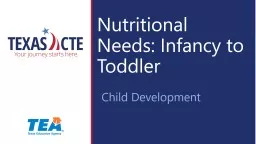

Child Development What is an ageappropriate diet for children Infant and Newborn Nutrition Food provides the energy and nutrients that babies need to be healthy Infants usually start eating solid foods between four and six months of age ID: 932859
Download Presentation The PPT/PDF document "Nutritional Needs: Infancy to Toddler" is the property of its rightful owner. Permission is granted to download and print the materials on this web site for personal, non-commercial use only, and to display it on your personal computer provided you do not modify the materials and that you retain all copyright notices contained in the materials. By downloading content from our website, you accept the terms of this agreement.
Slide1
Nutritional Needs: Infancy to Toddler
Child Development
Slide2Slide3What is an age-appropriate diet for children?
Slide4Infant and Newborn Nutrition
Food provides the energy and nutrients that babies need to be healthy
Infants usually start eating solid foods between four and six months of age
Slide5Birth to Four Months of Age
During the first four to six months of life, infants need only breast milk or formula to meet all their nutritional needs
Never give an infant honey
Slide6Four to Six Months of Age
Development to indicate an infant is ready to eat solid foods:
The baby can sit up with some support
The baby has good control of head and neck
The birth weight has doubled
Slide7Six to Eight Months of Age
For strained fruits and vegetables, introduce one at a time, waiting two to three days in between to check for any allergic reaction.
Slide8Eight to Twelve Months of Age
A baby is ready to try strained or finely chopped meats
Offer one new meat per week
Slide9One Year of Age
A one year old should be getting much of their nutrients from:
Breads and grains
Dairy group
Fruits and vegetables
Slide10Feeding Tips
Feeding solids too early is not recommended and can result in overfeeding
Offer only one new food at a time. Offer the new foods for a few days
Slide11Tips During Mealtime
A baby put in bed with a bottle can develop bottle mouth.
Feed the baby directly from the jar only if you use the entire jar contents.
Slide12Two Years and Older
After the age of two, it is recommended that diets:
Are moderately low in fat
Provide nutrient-dense foods
Contain a variety of foods from each food group
Slide13MyPlate
Put the plan into action by:
Choosing healthy beverages and snacks
Limiting the amount of empty calories
Providing healthy eating habits
Serving small portions
Source: ChooseMyPlate.gov
Slide14Start with Small Portions
Don't insist that children finish all the food on their plates
Teach them to take small amounts at first
Use smaller bowls, plates and utensils for your child to eat with
Slide15Nutritional Needs of Toddlers
The nutritional needs of toddlers vary from child to child
They should consume 1,000 to 1,400 calories per day
Slide16Behavioral Eating Milestones
Two-Year-
Olds
:
Can use a spoon and drink from a cup
Develop likes and dislikes
Experience slower growth and appetite drops
Three-Year-
Olds
:
Are comfortable using fork and spoon
Make simple either/or food choices, such as a choice of apple or orange slices
Pour liquid with some spills
Slide17How to Feed a Toddler
(click on picture)
Slide18Food Safety for Toddlers
Some foods are more likely to cause foodborne illness. Avoid serving your toddler the following foods:
Raw or partially cooked eggs or food containing raw eggs
Raw sprouts
Raw or undercooked meat, poultry, fish and shellfish
Unpasteurized juices
Unpasteurized (raw) milk or any products made from unpasteurized milk
Unwashed fruits or vegetables
Slide19Food Hazards for Toddlers
Foods that may be choking hazards:
Carrot sticks or baby carrots
Chewing gum
Chips
Peanuts
Popcorn
Round slices of hotdogs or sausages
Slide20Hand Washing Tips for Toddlers
Toddlers should wash hands:
After coughing or sneezing
After playing with pets or visiting a petting zoo
After using the bathroom
Before and after handling food or eating
Whenever they are dirty
Slide21Seafood Safety for Toddlers
Seafood (fish and shellfish) can be part of a healthy diet for toddlers.
Herring
Pollock
Salmon
Sardines
Trout
Slide22Review
What is an age-appropriate diet for a child under the age of one?
What is an age-appropriate diet for a toddler?
How can a parent use
ChooseMyPlate
to plan meals for a toddler?
Name four foods an individual should avoid serving a toddler.
What are three hand washing tips for toddlers?
Slide23Questions?
Slide24References and Resources
Images:
Photos obtained through a license with Shutterstock.com™. (Slides 1, 3, 4, 5, 6, 7, 8, 9, 10, 11, 12, 14, 15, 17, 18, 19, 20, 21 and 23)
ChooseMyPlate.gov. (Slide 13)
Textbook:
Decker, C. (2011). Child development early stages through age 12. (7th ed.). Tinley Park:
Goodheart
-Willcox Company, Inc.
Websites:
Bright Futures
Giving your baby the best nutrition (birth to five months)
http://www.brightfutures.org/nutritionfamfact/pdf/ColorEng/INB5color.pdf
Cut Back of Your Kid's Sweet Treats
10 tips to decrease added sugar. Nutrition Education Series.
http://www.choosemyplate.gov/food-groups/downloads/TenTips/DGTipsheet13CutBackOnSweetTreats.pdf
Slide25References and Resources
Websites:
Medline Plus
Age-appropriate diet for children
http://www.nlm.nih.gov/medlineplus/ency/article/002455.htm
Nutrition Education of Texas
Teaching Nutrition: Background information about nutrition, nutrients and healthy eating habits. Topics include nutrients, food safety, selecting a balanced diet, nutritional needs during the lifecycle, nutrition and health.
http://netx.squaremeals.org/teaching_nutrition.html
Nutrition.gov
Nutrition Information for you
http://www.nutrition.gov/life-stages/infants
United States of Department of Agriculture
The Centers for Disease Control (CDC), National Center for Health Statistics created these charts with direction from the FNS Supplemental Food Programs Division. http://wicworks.nal.usda.gov/assessment-tools/growth-charts/wic-growth-charts
Slide26References and Resources
YouTube™:
How to Feed a Toddler
Learn how to feed a toddler so that most of the food ends up in the child, not on him.
http://youtu.be/VV98HwqlQ7A